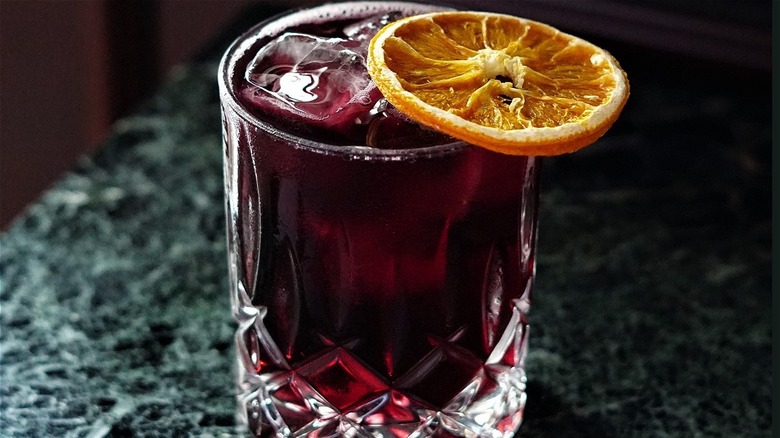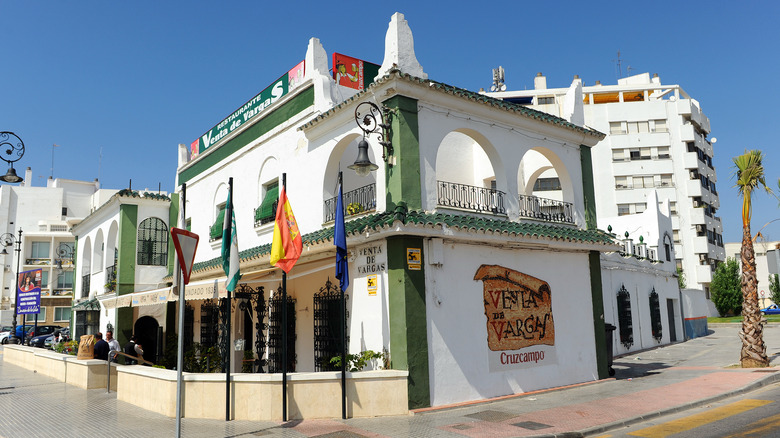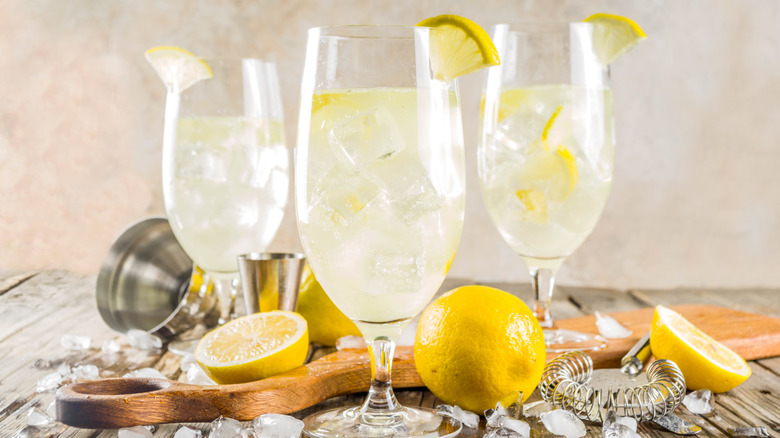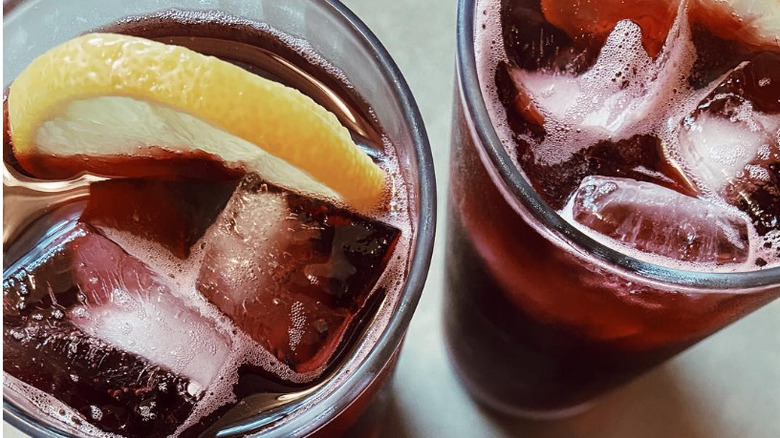Tinto De Verano Is The Lazy Sangria Substitute You Need This Summer
If you've never heard of a tinto de verano, you're not alone. However, the wine cocktail is incredibly popular in Spain in the summer months. The drink is ubiquitous in the Iberian Peninsula during the long hot season, and for good reason — it's refreshing, affordable, and incredibly easy to make. Many foreigners think of sangría as the Spanish red-wine drink of choice, but a glance around any crowded beach-side establishment reveals that the locals are more likely to be drinking glasses of tinto de verano instead.
But what exactly is a tinto de verano? The name literally means "red of summer" or summer red wine, and it's a simple mixture of red wine with soda, served chilled and finished with lemon and a bit of ice. It's perfect for summer sipping because the soda dilutes the wine's alcohol content, making for a lighter drink.
Spain is known for its red wine-producing regions, and a classic choice for a tinto de verano is tempranillo wine. The best tempranillo wines for a tinto de verano are less expensive, younger bottles. After all, you don't want to waste your best vintage on something you'll be watering down, but your drink won't be tasty if you use bad wine, so choose wisely. In Spain, the soda added is usually La Casera, which is a light, lemon soda similar to Sprite or 7-Up but not as sweet. While tastes vary, the usual ratio is 1:1 wine to La Casera.
Humble origins for tinto de verano
Where did the drink come from, and why does everyone love it? As is usually the case with popular items, it's hard to trace tinto de verano's exact origins, but most point to early 20th century Córdoba, a city in southern Spain, as the beginning of this fan favorite.
Restaurant owner Federico Vargas reportedly created the wine mixture. Vargas was the owner of Venta Vargas, a restaurant known for its flamenco scene and bohemian crowd. Vargas had the bright idea of stretching his wine a little further by creating a brighter, fizzy version of red wine by adding soda to it. Juan Valls, a Spanish bar owner, told Imbible, "In the beginning, it was called Valgas, because the drink was made with red wine from the old winery region Valdepeñas." However, it soon became known as "un Vargas" after its owner and eventually tinto de verano.
The delightful combination became known up and down the peninsula, and the tinto de verano has proliferated throughout the country in the decades since. The most traditional version of the cocktail includes just red wine and soda, with lemon for garnish, but something so prevalent can't help but inspire alternate versions as well.
Variations on a theme
While tempranillo wines are the traditional base, other wines can be substituted. Some obvious choices are other young reds like garnacha, pinot noir, Côtes du Rhône, and Beaujolais. People sometimes add vermouth to the mix, which gives the beverage a bit more edge and boosts the alcohol content.
There are regional variations as well. While the drink is generally made with red wine, some regions of Spain have their own substitutions. The region of Catalonia is famous for its cava (a sparkling white wine similar to Champagne, but more affordable). There is a version of a tinto that swaps cava for the red wine in the recipe — as strange as it is to call a drink a "summer red" when it's completely white. Asturias, in northwestern Spain, is known for its hard cider, which can also be used in place of wine — resulting in another pale, but delicious, version of the drink.
Those making cocktails where the soda brand La Casera is scarce typically use whatever lemon-lime soda is available locally. However, you can also substitute some lemon or lime seltzer for part of the soda, especially since not all lemon-lime sodas are created equal. Likewise, diet soda lowers the sugar content for those who prefer a lighter version. Even the lemon garnish can be swapped for an orange or other citrus.
Sangria's chill cousin
So what makes a tinto de verano different from sangría? A few essential elements distinguish the two, namely: the fruit, the fuss, and the proof. Cut fruit (usually oranges, peaches, and apples) plays a critical role in a good sangría, and additional sugar and higher-proof alcohol (typically, brandy) are almost always added, making sangría sweeter, more potent, and fruitier. In order for the fruit flavors to permeate the wine, the fruity-wine mix generally needs to sit overnight – meaning that sangría takes a good bit of time and forethought to make. That also makes it extraordinarily difficult to prepare at a regular bar, where pitchers of muddled fruit are not usually lying around.
A tinto de verano, on the other hand, is easy for most wine lovers to make, in Spain and elsewhere. It can be whipped up quickly with ingredients to which most mixologists have ready access. It also involves no sitting overnight, can be made in pitchers or in a single glass, and has a lower alcohol content. In short, it's perfect for lazy summer afternoons that drift happily — and easily — into summer nights.



